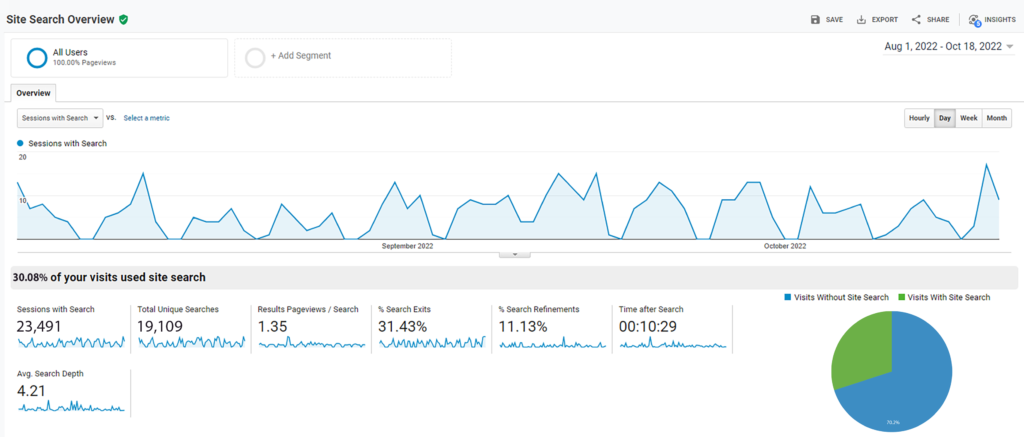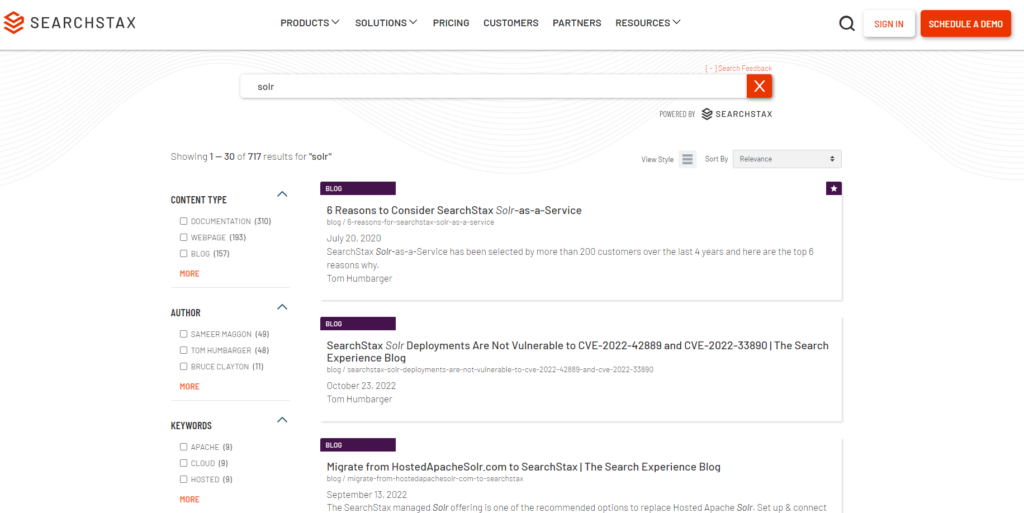Pictured is SearchStax’s website search page. Website visitors can search for content on the website using the search bar at the top. The most relevant results are then populated below.
SearchStax Site Search’s analytics dashboard allows marketers to review their site search data at a glance and also dive into full details for a broader picture of users’ wants and where the website results may fall short.
Both Google Analytics and a built-for site search tool allow marketers to uncover insights that can improve their website, though there are key differences in the available metrics and ease of use. Here is a comparison between the two.
Google Analytics Site Search Overview
Google Analytics includes site search analytics in the standard Universal Analytics and newer GA4 which is going to be the new standard for Google Analytics starting in summer 2023. (Note, this article looks specifically at Universal Analytics.)

The Site Search Overview Dashboard in Google Analytics shows overview metrics such as the number of sessions with search, total number of unique searches and time spent on the site after search.
Google Site Search Metrics Include:
- Percent of Website Visits that used Site Search
- Total Unique Searches
- Results Pageviews/Search (The average number of times a visitor visited a results page after performing a search)
- % Search Exits (The percentage of exits from your website after an internal site search)
- % Search Refinements (The percentage of times a search was entered and then transitioned to a new search.)
- Time after Search
- Average Search Depth (The number of pages visitors viewed after getting results for the search term)
- Search Terms and How Many Unique Searches
- What Start Pages have the most Unique Searches, % Search Exits, etc.
SearchStax Site Search Analytics Overview
Site Search includes key site search metrics in an easy-to-understand dashboard. This comes standard with Site Search and is set up during customer onboarding with an implementation specialist. The specialist can demonstrate all the site search metrics and explain further what insights you can learn from the data.

The Site Search Analytics dashboard shares similar metrics with Google Analytics and gives you a deeper understanding how users are engaging with the search results.
SearchStax Site Search Metrics Include:
- Total Searches
- Searches with Clicks
- Click-Through Rate
- Average Search Latency (How long it took to return search results)
- Average Click Position (The average position of the search results that had a click)
- Percentage of No Results Searches
- Metrics of Related Searches, including Clicks and CTR
- Searches per Session
- % Search Exits
- Search Terms and How Many Unique Searches
- Search Terms that had No Results and how many times the term was searched
- Search Terms with No Clicks
- Results that were the Most Clicked
- Results that were the Least Clicked
- Content Items – Impression Count, Click Count and Item Click-Through Rate
Overall Comparison – Google Analytics vs SearchStax
As you can see below, both Google Analytics and SearchStax Site Search offer benefits for digital marketers looking to understand and improve their website content. Because Site Search was built as a site search tool first and foremost, it is more user friendly and provides more in-depth site search metrics.
| Metric | Google Analytics | SearchStax Site Search |
| Sessions with Search | Y | Y |
| Total Unique Searches | Y | Y |
| Results Pageviews/Search | Y | Y |
| % Search Exits | Y | Y |
| % Search Refinements | Y | Y |
| Clickthrough Rate | – | Y |
| Number of Searches Without Results | – | Y |
| Search Terms that had No Results | – | Y |
| Start Page and What was Searched | Y | – |
| Search Terms and Destination Page | Y | Y |
| Content Metrics for Items | – | Y |
Google Analytics Pros and Cons |
| Pros | Cons |
| Easy to enable within Google Admin settings | Broad measurement doesn’t yield insights that people can take to improve content |
| Easy to understand overview statistics if you’re experienced with Google Analytics reports | Missing some useful metrics, such as clickthrough rate which is critical in estimating how relevant content is to the search |
| | No way to see what keywords users are using that yield no search results, crucial for identifying missing needs |
| | No way to see what keywords users are using that yield no clicks, which is another key metric for knowing how relevant content is. |
SearchStax Site Search Pros and Cons |
| Pros | Cons |
| Specifically built to run and analyze the website search experience | Currently doesn’t show the percent of site visits using site search |
| Intuitive dashboard that shows key metrics that can help create actionable steps to improving web content | |
| Customizable reports by filtering searches and content items based on key metrics | |
In addition, Site Search allows marketers and website owners the opportunity to improve the search function of their website easily and without any developer assistance. This includes features such as AI to add related searches, adding common misspellings, boosting promotions for certain keywords and more. Although Google Analytics is a great tool to have in your tool belt, the fact that Site Search was built with site search metrics in mind is key.
What Search Analytics are available with SearchStax Site Search?
- Total Searches
- Searches with Clicks
- Click-Through Rate
- Average Search Latency (How long it took to return search results)
- Average Click Position (The average position of the search results that had a click)
- Percentage of No Results Searches
- Metrics of Related Searches, including Clicks and CTR
- Searches per Session
- % Search Exits
- Search Terms and How Many Unique Searches
- Search Terms that had No Results and how many times the term was searched
- Search Terms with No Clicks
- Results that were the Most Clicked
- Results that were the Least Clicked
- Content Items – Impression Count, Click Count and Item Click-Through Rate
What Analytics are available with Site Search?
- Total Searches
- Searches with Clicks
- Click-Through Rate
- Average Search Latency (How long it took to return search results)
- Average Click Position (The average position of the search results that had a click)
- Percentage of No Results Searches
- Metrics of Related Searches, including Clicks and CTR
- Searches per Session
- % Search Exits
- Search Terms and How Many Unique Searches
- Search Terms that had No Results and how many times the term was searched
- Search Terms with No Clicks
- Results that were the Most Clicked
- Results that were the Least Clicked
- Content Items – Impression Count, Click Count and Item Click-Through Rate
What are the benefits of SearchStax Site Search Analytics vs. Google Analytics?
SearchStax Site Search offer benefits for digital marketers looking to understand and improve their website content. Because Site Search was built as a site search tool first and foremost, it is more user friendly and provides more in-depth site search metrics.
The key reasons include:
- Specifically built to run and analyze the website search experience
- Intuitive dashboard that shows key metrics that can help create actionable steps to improving web content
- Customizable reports by filtering searches and content items based on key metrics



